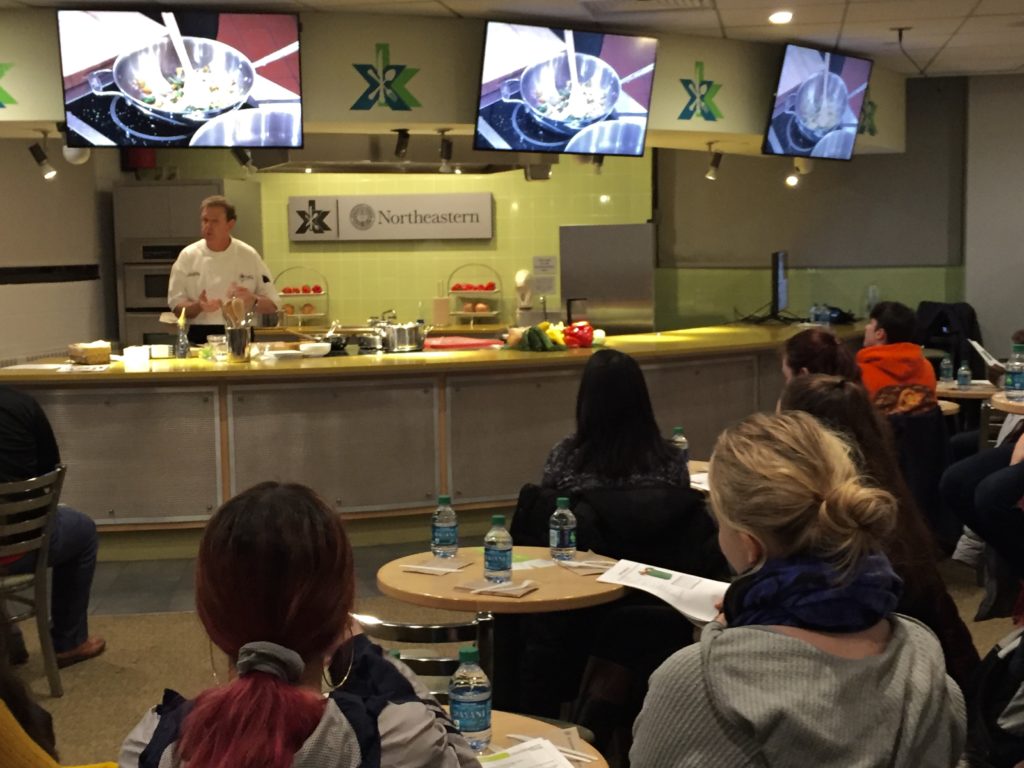NU Thrive event helps students eat well on a college budget
February 2, 2018
The freshman 15 may be a worry for some Northeastern students, but a group of NU students and faculty have some cost-effective tips they discussed at the event “Eating Right When Money’s Tight” on Wednesday night. The event centered around how to help combat unhealthy eating.
NU Thrive is a student-driven program through Northeastern’s Center for Financial Independence that aids students with personal finance and financial literacy. They partnered with Xhibition Kitchen, a branch of NU Dining that teaches cooking skills classes to students, to create the event to show students how to eat healthy on a college budget, said NU Thrive Chief Marketing Officer Carly Joos.
“In college you’re really kind of setting yourself up for life,” she said. “If you can learn how to eat healthy, you’re really going to be set up for the future.”
Tom Barton, NU’s executive chef who led the event, described ways to save money when buying healthy ingredients, such as buying in bulk.
“Smaller packs charge more,” Barton said. He explained that buying items in bulk allows you to use what you need and save the rest to use again later.
Saving and reusing leftover food is another effective way to save money on meals, Barton said. Instead of throwing away leftover rice or herbs, Barton recommended using them as a stuffing, sauce or salad dressing in a future meal.
“Maybe you went out for Chinese food and got some stir fry rice leftover. You can use that,” Barton said.
Preparing meals can seem very daunting to students, but they make it easy to be cost-effective, explained Joos, a fourth-year business administration major.
“Finances and personal finances really come up in every aspect of life,” she said. “It can be as far as cooking or meal prep or really anywhere you’re spending money.”
Some Northeastern students live in a dorm without a kitchen and are unable to cook for themselves, meaning they have less control over the types of food they eat. Some students worry about the health impacts of regularly eating food at the school’s dining halls.
“The portion sizes are larger in the cafeteria,” first-year behavioral neuroscience major Alyssa Townsend said. “I’m serving myself from this large selection of food, what kinds of food should I look for?”
According to Barton, a healthy portion of meat should be approximately the size of your fist. If grocery stores sell oversized portions, cook the proper amount and put the rest in the freezer to use later, Barton said.
Barton also pointed out the closest grocery stores may not be the most cost-effective places to shop. Wollaston’s Market and Whole Foods may be close by but are often overpriced, he said. Finding a store farther away might save you more money.
“You don’t have to spend all this money, you don’t have to shop at Whole Foods or buy meals out,” said Charlie Kline, a fourth-year finance major and NU Thrive CEO. “Anyone on a budget can really make good food for themselves.”
NU Thrive hosts weekly events like “Eating Right when the Budget is Tight” to help educate students on personal finance.
“Thrive is a great resource for students,” said Joos. “The sooner you start thinking about personal finance, the better.”







